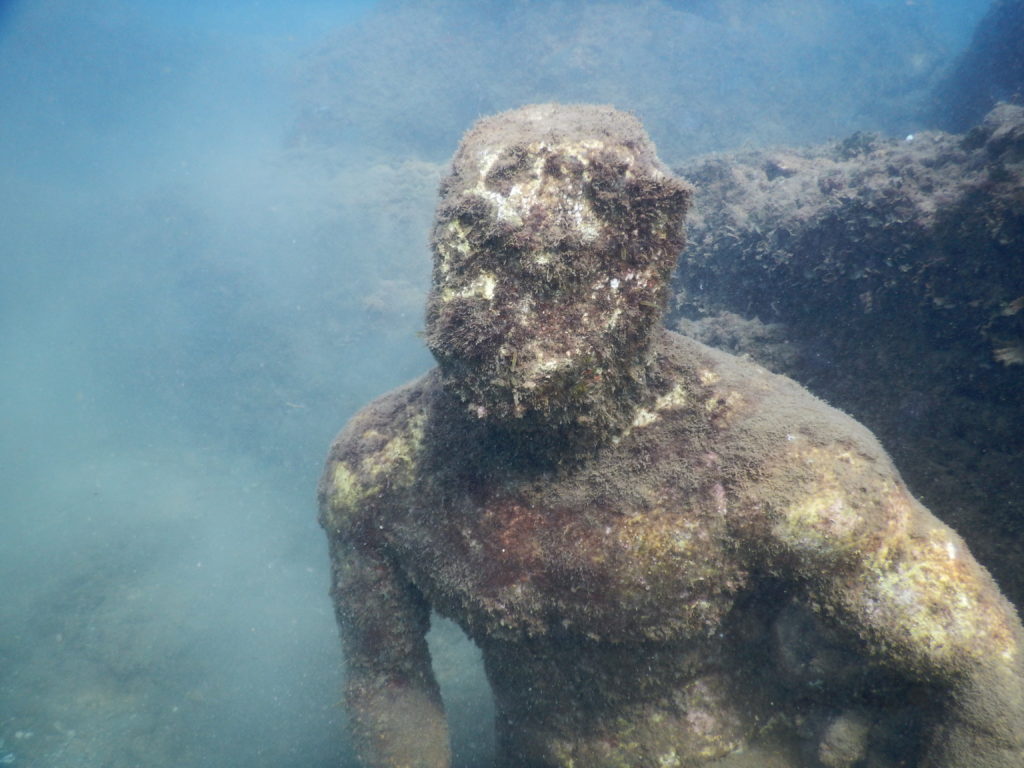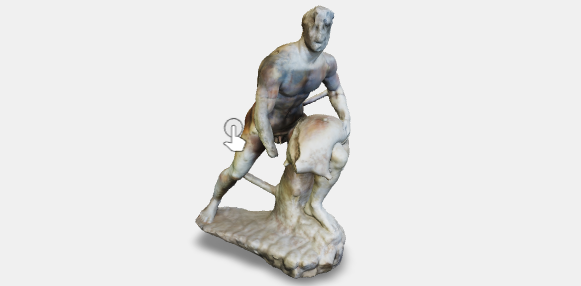The statue of Ulysses’ companion was found in the submerged Imperial Nymphaeum of Punta Epitaffio in January 1969, following a storm surge. Along with the statues of Polyphemus (now lost) and that of the Homeric hero, they were part of the decoration of the apse in the building of Baiae, characterized as a large antrum cyclopis.
The white marble sculpture, heavily damaged by lithodomes in the head, was initially interpreted as an anonymous slave in an offering pose. Now it is believed to depict Ulysses’ companion, naked with a goat wineskin resting on his left thigh, while filling a jug of wine for the cyclops, as it is referred in a famous episode of the Odyssey.
In the Hellenistic original, evidently made of bronze, the companion was conceived to be on a rock, in raised position and in background against Ulysses, like in the famous glass paste mosaic found in one of the vaults of the Emperor’s Nero Domus Aurea; according to the art historian Bernard Andreae, it does not depict a scene from Odyssey, but a bronze sculpture group that reproduced it. This would explain its small size when compared to Ulysses, along with other apparent inconsistencies in the pose. However, in the Nymphaeum, the group would have been organized in a symmetrical layout, with the two figures at the sides of the giant statue of Polyphemus.

Replica of the statue in situ (photo:M. Stefanile)
The conditions of the primary position of this statue, similarly to what happened to the statue of Ulysses, defined a different state of conservation. Nearly the whole body, except for the head, the neck and a part of the right arm, is perfectly preserved, as it was covered by the sediment.
The head shows conspicuous perforations dug by endolithic molluscs of the species of Lithophaga lithophaga, located mainly on the left side of the face. The entire head and the neck were densely colonized by boring sponges that produced clearly visible sub-globular cavities. The same alterations can be seen on a part of the right arm, in particular on the portion that was originally found detached. Such degradation indicates that the fragment of the arm was not covered with sand like the rest of the statue, but exposed to a water column and therefore to bioerosion by micro and macro-organisms. According to the morphology of eroded cavities, it can be assumed that the damage was caused by the species of Cliona celata, found in many other artefacts present on site.


Andreae, B. 1982. L’immagine di Ulisse. Mito e archeologia. Torino: Giulio Einaudi Editore, pp. 69-77
Andreae, B. 1983, Le sculture, in Zevi F., Baia. Il ninfeo imperiale sommerso di Punta Epitaffio. Banca Sannitica, pp. 50-52.
Avilia F., Caputo, P. 2015, Il ninfeo sommerso di Claudio a Baia. Napoli: Valtrend Editore.
Davidde B., Ricci S., Poggi D., Bartolini M., 2010. Marine bioerosion of stone artefacts preserved in the Museo Archeologico dei Campi Flegrei in the Castle of Baia (Naples), Archaeologia Maritima Mediterranea; 7: 75-115.
De Franciscis, A. 1969, La sorpresa sottomarina di Baia, in Il Domani d’Italia. Rivista meridionale di cultura e politica, 2, pp. 48-50.
Ricci S., Sacco Perasso C., Antonelli, F., Davidde Petriaggi B., 2015. Marine Bivalves colonizing roman artefacts recovered in the Gulf of Pozzuoli and in the Blue Grotto in Capri (Naples, Italy): boring and nestling species. International Biodeterioration & Biodegradation (98) 89 – 100.
Ricci, S., Pietrini, A. M., Bartolini, M., Sacco Perasso, C., 2013. Role of the microboring marine organisms in the deterioration of archaeological submerged lapideous artifacts (Baia, Naples, Italy). International Biodeterioration & Biodegradation 82 (2013) 199-206.
Ricci S., Davidde B., Bartolini M., Priori G. F., 2009. Bioerosion of lapideous objects found in the underwater archaeological site of Baia (Naples). Archaeologia Maritima Mediterranea, 6: 167-188.
Zevi F. 1983, Baia. Il ninfeo imperiale sommerso di Punta Epitaffio. Banca Sannitica.
Zevi F. (cur.) 2009, Museo archeologico dei Campi Flegrei. Castello di Baia. Napoli: Electa Napoli.



